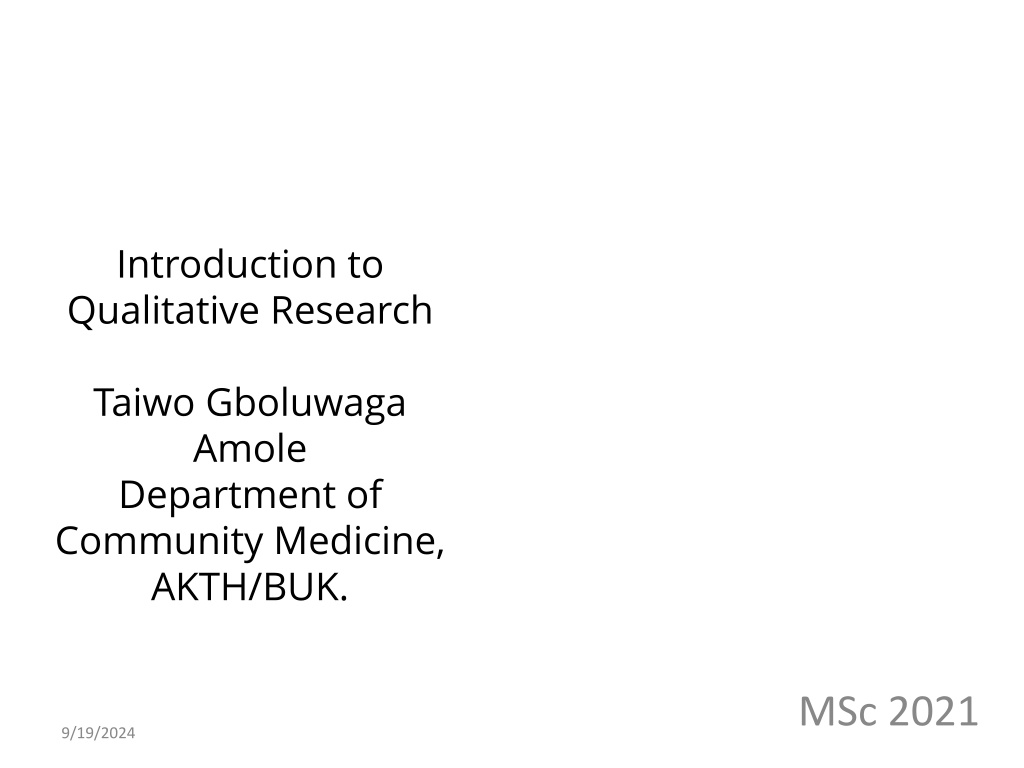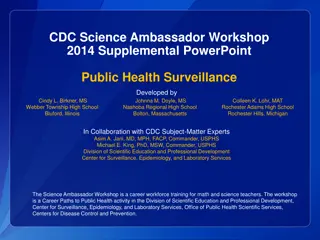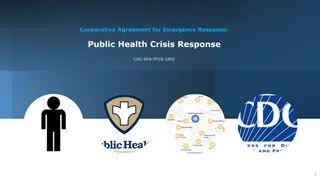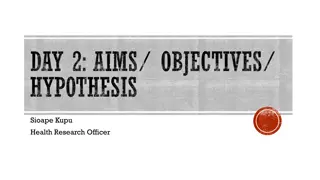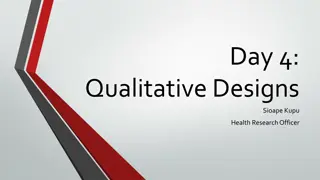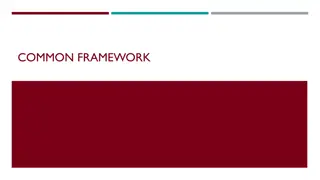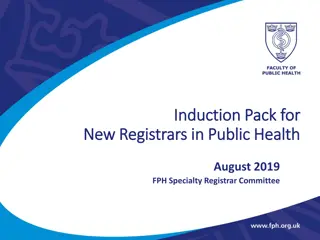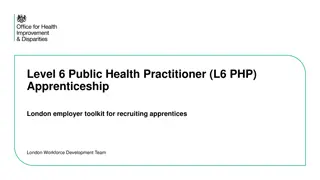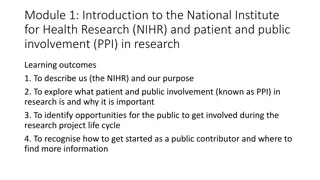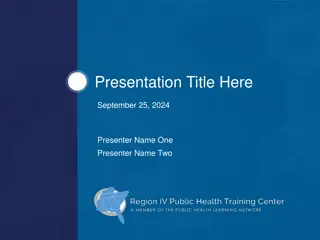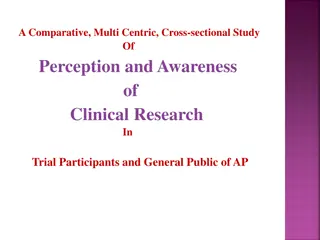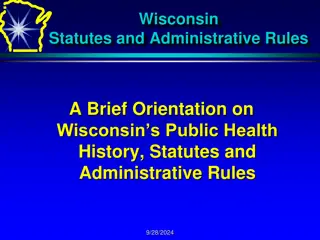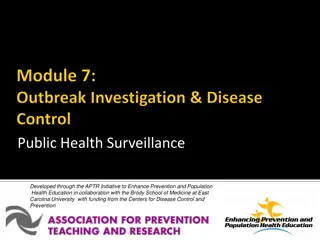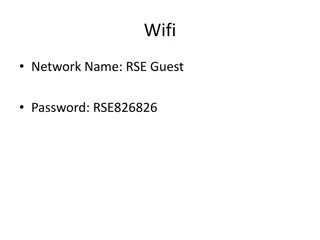Understanding Research Methods in Public Health
Exploring the nuances of qualitative and quantitative research methods in the context of public health, this content delves into how each approach offers unique insights and perspectives. It discusses the importance of qualitative research in uncovering underlying factors influencing health, interpreting community perceptions, and identifying implementation challenges. Contrasting qualitative and quantitative methodologies, it highlights their distinct characteristics, aims, and common practices through detailed examples and visual aids. Various research questions are presented, prompting consideration of which method - qualitative or quantitative - would be most suitable for addressing each query.
Uploaded on Sep 19, 2024 | 0 Views
Download Presentation

Please find below an Image/Link to download the presentation.
The content on the website is provided AS IS for your information and personal use only. It may not be sold, licensed, or shared on other websites without obtaining consent from the author. Download presentation by click this link. If you encounter any issues during the download, it is possible that the publisher has removed the file from their server.
E N D
Presentation Transcript
Introduction to Qualitative Research Taiwo Gboluwaga Amole Department of Community Medicine, AKTH/BUK. MSc 2021 9/19/2024
Why Qualitative? Qualitative methods help to: Answer how or why questions Explain the factors that influence health Understand how individuals and communities interpret certain public health issues or concepts Study/observe the interactions related to a public health issue or phenomenon Identify problems with implementation or relevance of public health tools or services 9/19/2024
What are some differences between qualitative and quantitative research? 9/19/2024
Qualitative vs. Quantitative Qualitative Research: Answers how and why Participant s perspective Explores hypotheses Describes (text) Common methods include: focus groups, individual interviews, and participation/observations Small sample size, more depth, less structure Quantitative Research: Answers who , what , how much & where Researcher s perspective Confirms hypotheses Quantifies (numbers) Common methods include: surveys, interviews, longitudinal studies, and controlled observations. Large sample size, less depth, more structure 9/19/2024
Would you conduct a qualitative or quantitative study? RQ: Does the post-natal health education program in Malawi improve the health status of children up to one year old? 9/19/2024
Would you conduct a qualitative or quantitative study? RQ: What are the experiences of parents with sick children at Kampala General hospital? 9/19/2024
Would you conduct a qualitative or quantitative study? RQ: How do women in Lagos choose their husbands? 9/19/2024
Would you conduct a qualitative or quantitative study? RQ: Do adolescent women served by the Family Planning Clinic in Addis return to the clinic on-time for their Depo-Provera shots? 9/19/2024
What types of qualitative studies have you worked on or heard of? 9/19/2024
Common Qualitative Methods Observation Interviews Unstructured: questions generated spontaneously from interviewee s responses Structured: adherence to specific set of questions Semi-structured: happy medium allow space for interviewees to answer in their own words but covers same topics and questions across interviews Focus Group Discussions 9/19/2024
Data Collection Materials Note taking Field note journal Structured observation note grid Brief notations while in the field Video and/or tape recording (with permission) Collection of all relevant supporting materials 9/19/2024
Considerations in Planning Qualitative Research Before forming qualitative research questions, there are a few key things to consider which differ from the considerations made for quantitative research: Goals and objectives of the study Who you are studying (vs. what, as studied in quantitative) Sample is often not random Sample may not be representative of the total population Level of rigor may not be the same as quantitative Triangulation: use of different methods to check for consistency Role of the researcher Maintaining objectivity 9/19/2024
Qualitative Research Questions Open-ended Purpose: To understand thoughts, ideas, perspectives, attitudes, and/or beliefs To help inform a hypothesis To understand how/why people interpret certain public health issues To generate new avenues of study To inform an intervention, service, or study design May begin with how , why , in what ways , etc. May change over time 9/19/2024
Practice What are some questions from your own work that would be better asked qualitatively than quantitatively? How would you frame the question? What type of qualitative research would you do? How would you design the study? 9/19/2024
Focus Group Discussions (FGDs) 9/19/2024
Definition: a research technique that collects data through group interaction on a topic determined by the researcher 9/19/2024
When focus groups are used? Suitable for: Social norms Feedback on a product Observations of how participants talk to each other about a topic Insights into group interaction Must be: For research purposes Focused on one topic Require discussion between participants 9/19/2024
Strengths of focus groups Need to know group/population consensus Relative to individual interviews Direct evidence about similarities and differences Less threatening (safety in numbers) Sense of varied responses in public vs. private Relative to observations Keeps discussion on a topic Phenomena that are unobservable (decision- making, private or rare actions) 9/19/2024
Advantages/disadvantages of focus groups Disadvantages Logistically challenging to gather that many people Must have a skilled moderator Participants can have lengthy responses or a few people can dominate the discussion Not useful for gathering in-depth data on personal or sensitive topics Confidentiality cannot be assured Advantages Relatively cheap Accepting environment Comments stimulate others to think about the topic 9/19/2024
Purpose of FGD guide To inform moderator of key questions To guide phrasing of questions and transitioning To keep session on track Includes fewer questions but centers them each around one theme or dimension Probe more deeply if necessary use this only as a guide 9/19/2024
Planning & organization Who: Recruitment, invitation, and organization of groups Want participants similar in background, not attitudes Where/When: Convenience, accessibility, and type Want a neutral, convenient, private place Each group lasts 1-2 hours (time/travel considerations) What: Participatory activities Moderator involvement only to allow free flowing conversation and ensure research topics covered Snacks: Yes/no, before/during/after How many: Number and size of groups Ideally 6-10, or <12 participants per group 3-5 groups per project/subgroup 9/19/2024
Roles of the FGD team Two interviewers per FGD: Moderator Notetaker/ Logistics Coordinator May need to switch hats Important to plan ahead: Discuss roles Prepare using mock or pilot FGDs Anticipate challenges, cross-critique, exchange roles as needed Continuous training via daily debriefings 9/19/2024
Moderator Must be a good listener and a good observer Goals: Keep the discussion on track and paced Maximize interaction between participants Stress each participant's value and contribution Emphasizes own role as a LEARNER, not a TEACHER Allow and value outbursts Plan: 1. Obtain informed consent/assent 2. Start audio-recording with oral group consent 3. Introduction, establish ground rules 4. Self-introductions and ice-breakers 9/19/2024
Notetaker/ Logistics Coordinator Notetaking goal: to ensure detailed documentation of the FGD Setting and participant description Participant responses Note who is speaking using naming convention (quotes) Notetaker's observations Logistics goals: Limit distraction to FGD Respond to all unanticipated interruptions or problems Prepare and coordinate research tools Offer insight on unnoticed group interactions Check recording device Keep track of time 9/19/2024
Positive dynamics to encourage Participants are relaxed and mutually respectful of the group Be relaxed, use pleasant tone Be patient, don't rush to respond Incorporate humor Co-create/omit ground rules Avoid judging comments Avoid informing/educating during the group ("expert") Group has taken a comfortably outgoing, serious, or quiet tone or dynamic Allow group to follow it's own style and pace Be flexible Ask one question at a time 9/19/2024
Difficult dynamics to manage Moderator has to work to keep the group attention/focus on topic Modify guide to get in sync with participant's perspectives/terms Use less moderator involvement Dissenters suppress disagreement to maintain group consensus Opening/final statements to discussion questions Emphasize wanting diverse views Discussion angers, slows down, or is monopolized Acknowledge emotion, take a break Redirect towards interests Invite others to comment 9/19/2024
What are some ground rules that you could set to help manage these difficult situations? 9/19/2024
Final tips Moderator needs to anticipate language/translation needs Notetaker to be prepared to fill-in for moderator Notetaker to be aware if note-taking is distracting All familiar with recording devices Notetaker to be prepared to ensure ongoing private and noise-free space 9/19/2024
Overview of In-depth Interviews (IDIs) 9/19/2024
Why conduct interviews? Interviews allow for a more incisive look into the context, issue, or public health concept Help to gain an understanding of underlying reasons, opinions, and motivations for certain trends or issues Provide a safe space for exploring deeper into a problem or concept 9/19/2024
Types of Interviews Informal: Conversations in the field Unstructured: Interview setting with no formal guide Semi-structured: Interview setting with an interview guide & probes Structured: Interview setting with a rigid question list 9/19/2024
Structured vs. Unstructured: Interviewer Perspective STRUCTURED Standardized across multiple interviewers Can rely on the script Data has less researcher influence May be self-administered if necessary May constrain depth of understanding Some relevant or important topics may not get covered SEMI- OR UN-STRUCTURED Less or not standardized Ideal for fewer interviewers Personal style/influence of the researcher is a key factor Room to develop rapport and explore certain themes/topics Quality of data depends on the interviewer's skills and judgement Can't be self-administered 9/19/2024
Structured vs. Unstructured: Data Collection Perspective STRUCTURED Pre-determined Systematic Pre-set range of responses Quantitative Good for getting specifics Not ideal for deep discussion or understanding SEMI- OR UN-STRUCTURED Not pre-determined Open-ended, free response Less control over nature of responses Qualitative/narrative research Allowed to change based on responses Good for in-depth knowledge Difficult to compare data between respondents 9/19/2024
Before the Interview: Considerations Time of day, venue, environment Audience dynamics and demographics Cost to the participant (time, money, energy) to attend Safety consideration Written materials: Literacy of the audience Language barriers that may affect the presentation Recording and note taking Ethical considerations Personal influence/role of the researcher (reflexivity) 9/19/2024
Consent Types: Oral and Written Can be done before or at the time of the interview Purposes: Provides a brief introduction to the study team and project Ensures the participant fully understands her/his involvement in the interview/discussion and the confidentiality of responses Makes participant aware of how personal details, responses, and observations will be recorded, collected, and disseminated Allows the participant to opt out, express hesitations/concerns, or ask questions 9/19/2024
Building Rapport Rapport: Establishing a mutually trusting and respectful relationship with the participant Rapport can change or develop over time and circumstances Depends on: Culture-sharing group Participant(s) Interviewer(s) Stages of an interview: Apprehension Exploration Cooperation Participation 9/19/2024
Apprehension Sense of uncertainty Interviewee doesn t know what to expect, purpose, or motivation Uneasy about potential judgment of responses Doubtful of adequate experience to report What to do? Keep informants talking (...?) Expand on informed consent process/explanations Start and demonstrate... 9/19/2024
Exploration Apprehension gives way to trying out the relationship Form opinion about what interviewer really wants Answering questions appropriately? Is it OK to talk about a specific topic? Begins to become familiar with process How do you know you re in this stage? May offer tangential story Appears to be at ease States unspoken questions 9/19/2024
Cooperation Interviewer/-ee know what to expect from one another and move into full cooperation Work together towards same end Difference b/t rich vs. thin data How do you know you re here? Mutual less concern about offense/mistakes Interviewee may self-probe, correct, verify Satisfaction with exchange 9/19/2024
Participation Final stage in rapport building process After multiple encounters Interviewee takes more assertive role On look-out for new information, consideration Involvement in analysis or dissemination Is this stage crucial? Empowerment, mobilization Member checking/validation Qualitative rapid assessment In-depth cooperation gives saturation 9/19/2024
Conversation vs. Qualitative Interview Brief, sometimes physical contact Friendly Conversation Qualitative Interview Greeting Extended, instructional, introductions Explicit Purpose Lacking, not stated or questioned Consent, verification, study eligibility, recording process, research questions Non-judgemental probing questions, seeking detail and clarification Acknowledgement, validation, and encourage to continue talking; native language explanations Expressing Interest Expressing Ignorance Confirmatory/disconfirmatory statements (e.g.,"Wow!") Encourage to continue talking Taking Turns Fluid, balanced participation Asymmetrical, interviewee talks more with "control" by interviewer Further inquiry on references/partial hints Abbreviating Understood references or partial hints Pausing Indicative of natural flow Time for reflection for both parties, review notes, coping, awkward Part of conscious iteration, emphasizing purpose or explanation Gratitude, next steps, data use, more responses/question, payment process, closing statements Repeating Not necessarily intentional Leave Taking Brief, not necessarily purposeful 9/19/2024
Introduction Introduce yourself Help the participant(s) to feel comfortable Get consent, if not already done State the purpose of your interview or discussion Provide a basic outline of what he/she should expect (duration, interactive components, etc.) Allow room for questions or concerns to be voiced 9/19/2024
Questions Ask the same questions in the same manner to each participant Important to consider the sensitive nature of questions For structured or semi-structured interviews, follow the script as closely as possible Do not offer extraneous information Do not lead, suggest, or inject an opinion Remain neutral throughout the interview If you disagree with the participant, do not argue Provide clarification and probing questions as needed 9/19/2024
Probes Natural phrase, question, gesture, and/or sound to encourage the participant to speak more or elaborate on her answer Probing Probes help to dig deeper and help guide the discussion Not all probing questions have to be used Use when response is brief or unclear Indicate active listening Important not to probe too much or too little 9/19/2024
Types of Probes Direct questions on how , why , what do you mean ? Neutralverbal expressions, nodding ( Uh-huh probe) Mirroring technique / Echo probe (repeating prior point) Silent probe(remaining quiet) Exploratoryprobe ( What else? Tell me more about... ) Baiting/phased assertion probes (Hint of already knowing) 9/19/2024
Clarification If a participant asks for clarification, goes off topic, or gives an irrelevant answer, then there a few key methods for responding: Repeat the question Frame the question a different way Provide context Use different descriptors that provide the same or similar meaning Utilize the probing questions Paint a clearer picture of what you are trying to understand 9/19/2024
Balancing Listening, Talking, & Silence Some silence is OK! Listen more, talk less Explore laughter Follow-up, but don t interrupt Only share personal experiences occasionally Ask questions when you don t understand 9/19/2024
Closing Remember to thank the participant for his or her time Remain professional and pleasant, and provide contact information for any questions the participant may have about the investigation and/or the survey. Quickly review what was discussed before you conclude the interview to make sure all questions have been answered Allow room for any remaining thoughts or questions Administer the exit survey as applicable Ensure participants have a safe and reliable means of transportation Connect to local resources as needed 9/19/2024
Qualitative Research Ethics 9/19/2024
Top priority in research Protect the well-being of research participants Research question is always of secondary importance Choice between doing harm to participant and doing harm to the research: always protect the participant! 9/19/2024
